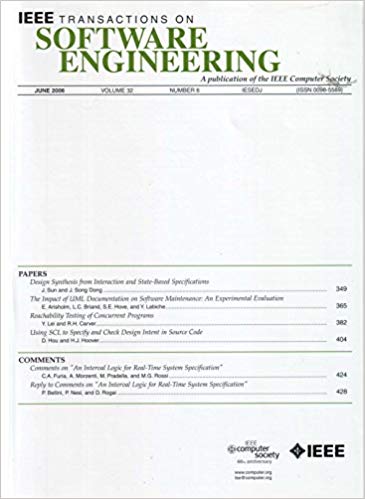Testing CPS With Design Assumptions-Based Metamorphic Relations and Genetic Programming
IF 5.6
1区 计算机科学
Q1 COMPUTER SCIENCE, SOFTWARE ENGINEERING
引用次数: 0
Abstract
Cyber-Physical Systems (CPSs) software is used to enforce desired behaviours on physical systems. To test the interaction between the CPS software and the system’s physics, engineers provide traces of desired physical states and observe traces of the actual physical states. CPS requirements describe how closely the actual physical traces should track the desired traces. These requirements are typically defined for specific, simple input traces such as step or ramp sequences, and thus are not applicable to arbitrary inputs. This limits the availability of oracles for CPSs. Our recent work proposes an approach to testing CPSs using control-theoretical design assumptions instead of requirements. This approach circumvents the oracle problem by leveraging the control-theoretical guarantees that are provided when the design assumptions are satisfied. To address the test case generation and oracle problems, researchers have proposed metamorphic testing, which is based on the study of relations across tests, i.e., metamorphic relations (MRs). In this work, we define MRs based on the design assumptions and explore combinations of these MRs using genetic programming to generate CPS test cases. This enables the generation of CPS input traces with potentially arbitrary shapes, together with associated expected output traces. We use the deviation from the expected output traces to guide the generation of input traces that falsify the MRs. Our experiment results show that the MR-falsification provides engineers with new information, helping them identify passed and failed test cases. Furthermore, we show that the generation of traces that falsify the MRs is a non-trivial problem, which cannot be addressed with a random generation approach but is successfully addressed by our approach based on genetic search.基于设计假设的变质关系和遗传规划检验CPS
网络物理系统(cps)软件用于在物理系统上强制执行所需的行为。为了测试CPS软件与系统物理之间的相互作用,工程师提供了所需物理状态的轨迹,并观察了实际物理状态的轨迹。CPS需求描述了实际物理走线与期望走线的跟踪程度。这些要求通常是为特定的、简单的输入轨迹(如阶跃或斜坡序列)定义的,因此不适用于任意输入。这限制了cps的oracle可用性。我们最近的工作提出了一种使用控制理论设计假设而不是需求来测试cps的方法。这种方法通过利用在满足设计假设时提供的控制理论保证来规避oracle问题。为了解决测试用例生成和oracle问题,研究人员提出了基于测试之间关系研究的变形测试,即变形关系(MRs)。在这项工作中,我们根据设计假设定义了MRs,并使用遗传编程来探索这些MRs的组合,以生成CPS测试用例。这样就可以生成具有任意形状的CPS输入走线,以及相关的预期输出走线。我们使用与预期输出轨迹的偏差来指导生成伪造mrs的输入轨迹。我们的实验结果表明mr -证伪为工程师提供了新的信息,帮助他们识别通过和失败的测试用例。此外,我们表明伪造MRs的痕迹的产生是一个非平凡的问题,不能用随机生成方法解决,但我们基于遗传搜索的方法成功地解决了这个问题。
本文章由计算机程序翻译,如有差异,请以英文原文为准。
求助全文
约1分钟内获得全文
求助全文
来源期刊

IEEE Transactions on Software Engineering
工程技术-工程:电子与电气
CiteScore
9.70
自引率
10.80%
发文量
724
审稿时长
6 months
期刊介绍:
IEEE Transactions on Software Engineering seeks contributions comprising well-defined theoretical results and empirical studies with potential impacts on software construction, analysis, or management. The scope of this Transactions extends from fundamental mechanisms to the development of principles and their application in specific environments. Specific topic areas include:
a) Development and maintenance methods and models: Techniques and principles for specifying, designing, and implementing software systems, encompassing notations and process models.
b) Assessment methods: Software tests, validation, reliability models, test and diagnosis procedures, software redundancy, design for error control, and measurements and evaluation of process and product aspects.
c) Software project management: Productivity factors, cost models, schedule and organizational issues, and standards.
d) Tools and environments: Specific tools, integrated tool environments, associated architectures, databases, and parallel and distributed processing issues.
e) System issues: Hardware-software trade-offs.
f) State-of-the-art surveys: Syntheses and comprehensive reviews of the historical development within specific areas of interest.
 求助内容:
求助内容: 应助结果提醒方式:
应助结果提醒方式:


